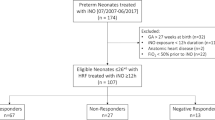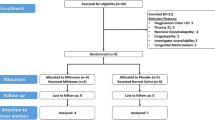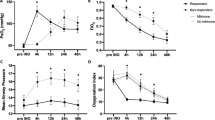Abstract
Objective
To evaluate inhaled nitric oxide (iNO) in preterm (PT) vs term/near-term (TNT) neonates with hypoxic respiratory failure (HRF) and pulmonary hypertension (PH) in an observational registry (PaTTerN).
Study design
Non-inferiority study comparing PT neonates of GA ≥ 27 to <34 weeks vs TNT neonates of GA ≥ 34 to ≤40 weeks with HRF associated with PH, who received iNO for 24–96 h during the first 0–7 days after birth. Primary endpoint: Achieving ≥25% decrease in oxygenation index/surrogate oxygenation index during iNO treatment.
Results
Of 140 neonates (PT, n = 55; TNT, n = 85), the primary endpoint was achieved in 50 (90.9%) PT vs 75 (88.2%) TNT neonates (difference [95% CI]: 0.027 [−0.033, 0.087]); PT neonates achieved non-inferiority interval, and the study was stopped early based on prespecified criteria.
Conclusions
Use of iNO for improving oxygenation in PT neonates with HRF associated with PH is at least as effective as in TNT neonates.
Clinical trial registration
#NCT03132428, registered April 27, 2017
This is a preview of subscription content, access via your institution
Access options
Subscribe to this journal
Receive 12 print issues and online access
$259.00 per year
only $21.58 per issue
Buy this article
- Purchase on Springer Link
- Instant access to full article PDF
Prices may be subject to local taxes which are calculated during checkout



Similar content being viewed by others
Data availability
Discussion of statistical endpoints and analysis are included in the manuscript. Summary aggregate (basic) results (including adverse events information) and the study protocol will be available on clinicaltrials.gov (NCT03132428) when required by regulation. Individual de-identified patient data will not be disclosed. Requests for additional information should be directed to the company at medinfo@mnk.com.
References
Frostell C, Fratacci MD, Wain JC, Jones R, Zapol WM. Inhaled nitric oxide. A selective pulmonary vasodilator reversing hypoxic pulmonary vasoconstriction. Circulation. 1991;83:2038–47.
Frostell CG, Blomqvist H, Hedenstierna G, Lundberg J, Zapol WM. Inhaled nitric oxide selectively reverses human hypoxic pulmonary vasoconstriction without causing systemic vasodilation. Anesthesiology. 1993;78:427–35.
Clark RH, Kueser TJ, Walker MW, Southgate WM, Huckaby JL, Perez JA, et al. Low-dose nitric oxide therapy for persistent pulmonary hypertension of the newborn. Clinical Inhaled Nitric Oxide Research Group. N Engl J Med. 2000;342:469–74.
Davidson D, Barefield ES, Kattwinkel J, Dudell G, Damask M, Straube R, et al. Inhaled nitric oxide for the early treatment of persistent pulmonary hypertension of the term newborn: a randomized, double-masked, placebo-controlled, dose-response, multicenter study. The I-NO/PPHN Study Group. Pediatrics. 1998;101:325–34.
The Neonatal Inhaled Nitric Oxide Study Group. Inhaled nitric oxide in full-term and nearly full-term infants with hypoxic respiratory failure. The Neonatal Inhaled Nitric Oxide Study Group [published correction appears in N Engl J Med. 1997;337:434]. N Engl J Med. 1997;336:597–604.
Cole FS, Alleyne C, Barks JD, Boyle RJ, Carroll JL, Dokken D, et al. NIH Consensus Development Conference statement: inhaled nitric-oxide therapy for premature infants. Pediatrics. 2011;127:363–9.
Schreiber MD. Response to Kumar on behalf of the AAP committee on fetus and newborn. Pediatrics. 2014. https://pediatrics.aappublications.org/content/133/1/164/tab-e-letters#response-to-kumar-on-behalf-of-the-aap-committee-on-fetus-and-newborn.
The Franco-Belgium Colalborative NO Trial Group. Early compared with delayed inhaled nitric oxide in moderately hypoxaemic neonates with respiratory failure: a randomised controlled trial. The Franco-Belgium Collaborative NO Trial Group. Lancet. 1999;354:1066–71.
Field D, Elbourne D, Truesdale A, Grieve R, Hardy P, Fenton AC, et al. Neonatal ventilation with inhaled nitric oxide versus ventilatory support without inhaled nitric oxide for preterm infants with severe respiratory failure: the INNOVO multicentre randomised controlled trial (ISRCTN 17821339). Pediatrics. 2005;115:926–36.
Kinsella JP, Walsh WF, Bose CL, Gerstmann DR, Labella JJ, Sardesai S, et al. Inhaled nitric oxide in premature neonates with severe hypoxaemic respiratory failure: a randomised controlled trial. Lancet. 1999;354:1061–5.
Su PH, Chen JY. Inhaled nitric oxide in the management of preterm infants with severe respiratory failure. J Perinatol. 2008;28:112–6.
Van Meurs KP, Wright LL, Ehrenkranz RA, Lemons JA, Ball MB, Poole WK, et al. Inhaled nitric oxide for premature infants with severe respiratory failure. N Engl J Med. 2005;353:13–22.
Kinsella JP, Cutter GR, Walsh WF, Gerstmann DR, Bose CL, Hart C, et al. Early inhaled nitric oxide therapy in premature newborns with respiratory failure. N Engl J Med. 2006;355:354–64.
Van Meurs KP, Hintz SR, Ehrenkranz RA, Lemons JA, Ball MB, Poole WK, et al. Inhaled nitric oxide in infants >1500 g and <34 weeks gestation with severe respiratory failure. J Perinatol. 2007;27:347–52.
Mercier JC, Hummler H, Durrmeyer X, Sanchez-Luna M, Carnielli V, Field D, et al. Inhaled nitric oxide for prevention of bronchopulmonary dysplasia in premature babies (EUNO): a randomised controlled trial. Lancet. 2010;376:346–54.
Hasan SU, Potenziano J, Konduri GG, Perez JA, Van Meurs KP, Walker MW, et al. Effect of inhaled nitric oxide on survival without bronchopulmonary dysplasia in preterm infants: a randomized clinical trial. JAMA Pediatr. 2017;171:1081–9.
Jiang Q, Gao X, Liu C, Chen D, Lin X, Xia S, et al. Early inhaled nitric oxide in preterm infants <34 weeks with evolving bronchopulmonary dysplasia. J Perinatol. 2016;36:883–9.
Kinsella JP, Cutter GR, Steinhorn RH, Nelin LD, Walsh WF, Finer NN, et al. Noninvasive inhaled nitric oxide does not prevent bronchopulmonary dysplasia in premature newborns. J Pediatr. 2014;165:1104–1108.e1101.
Subhedar NV, Ryan SW, Shaw NJ. Open randomised controlled trial of inhaled nitric oxide and early dexamethasone in high risk preterm infants. Arch Dis Child Fetal Neonatal Ed. 1997;77:F185–190.
Dani C, Bertini G, Pezzati M, Filippi L, Cecchi A, Rubaltelli FF. Inhaled nitric oxide in very preterm infants with severe respiratory distress syndrome. Acta Paediatr. 2006;95:1116–23.
Schreiber MD, Gin-Mestan K, Marks JD, Huo D, Lee G, Srisuparp P. Inhaled nitric oxide in premature infants with the respiratory distress syndrome. N Engl J Med. 2003;349:2099–107.
Ballard RA, Truog WE, Cnaan A, Martin RJ, Ballard PL, Merrill JD, et al. Inhaled nitric oxide in preterm infants undergoing mechanical ventilation: the NO CLD Study Group. N Engl J Med. 2006;355:343–53.
Abman SH, Hansmann G, Archer SL, Ivy DD, Adatia I, Chung WK, et al. Pediatric Pulmonary Hypertension: Guidelines From the American Heart Association and American Thoracic Society. Circulation. 2015;132:2037–99.
Kumar P. Use of inhaled nitric oxide in preterm infants. Pediatrics. 2014;133:164–70.
Suzuki S, Togari H, Potenziano JL, Schreiber MD. Efficacy of inhaled nitric oxide in neonates with hypoxic respiratory failure and pulmonary hypertension: the Japanese experience. J Perinat Med. 2018;46:657–63.
Rhine WD, Suzuki S, Potenziano JL, Escalante S, Togari H. An analysis of time to improvement in oxygenation in Japanese preterm and late preterm or term neonates with hypoxic respiratory failure and pulmonary hypertension. Clin Ther. 2019;41:910–9.
Farrington CP, Manning G. Test statistics and sample size formulae for comparative binomial trials with null hypothesis of non-zero risk difference or non-unity relative risk. Stat Med. 1990;9:1447–54.
Acknowledgements
Medical writing and editorial support, which was conducted in accordance with Good Publication Practice (GPP3) and the International Committee of Medical Journal Editors (ICMJE) guidelines, was provided by Michael D. Morren, RPh, MBA, of Peloton Advantage, LLC, an OPEN Health company, and was funded by Mallinckrodt Pharmaceuticals. The authors wish to thank the patients’ families and research coordinators for participating in the registry.
Funding
This study was funded by Mallinckrodt Pharmaceuticals.
Author information
Authors and Affiliations
Contributions
JPK contributed to the study design. SEC, EP, and LDN were study investigators, and enrolled patients. EP collected and assembled the data. All authors contributed to the data interpretation, paper review and revisions, and provided final approval on the submitted draft.
Corresponding author
Ethics declarations
Competing interests
JPK received an investigator-initiated grant from Mallinckrodt to fund a registry for preterm newborns with pulmonary hypertension. ET is an employee of Mallinckrodt Pharmaceuticals and may hold stock or stock options in that company. JLP is a former employee of Mallinckrodt Pharmaceuticals. All other authors declare no competing interests.
Additional information
Publisher’s note Springer Nature remains neutral with regard to jurisdictional claims in published maps and institutional affiliations.
Supplementary information
Rights and permissions
About this article
Cite this article
Nelin, L., Kinsella, J.P., Courtney, S.E. et al. Use of inhaled nitric oxide in preterm vs term/near-term neonates with pulmonary hypertension: results of the PaTTerN registry study. J Perinatol 42, 14–18 (2022). https://doi.org/10.1038/s41372-021-01252-x
Received:
Revised:
Accepted:
Published:
Issue Date:
DOI: https://doi.org/10.1038/s41372-021-01252-x



